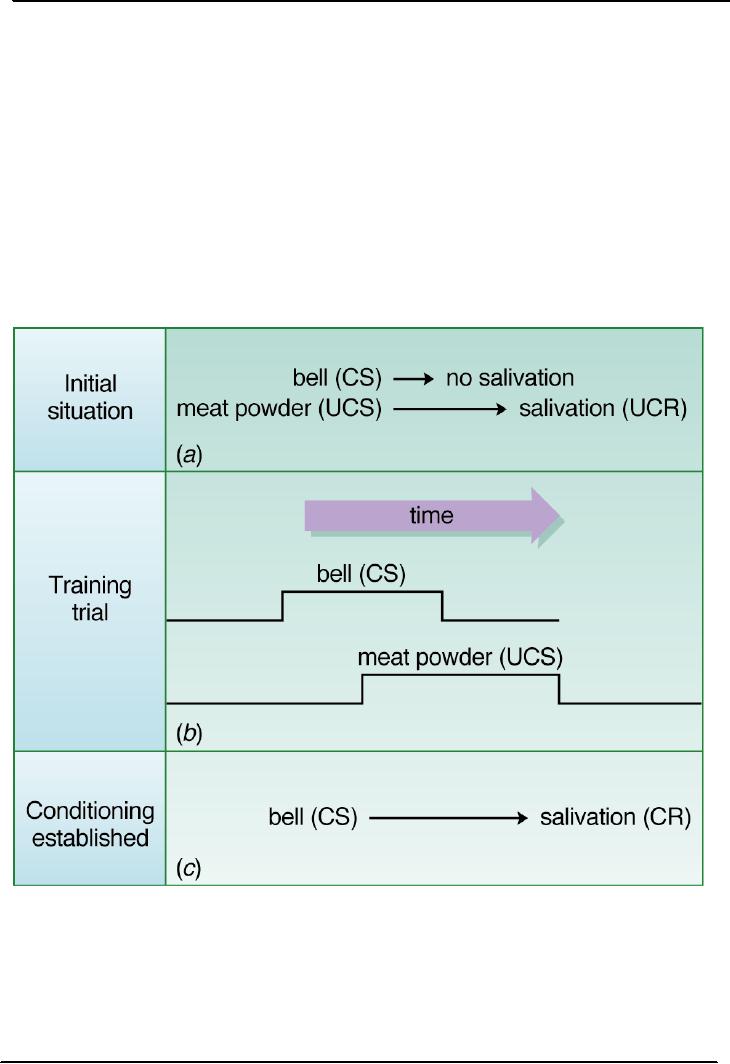 |

Theory
and Practice of Counseling -
PSY632
VU
LESSON
35
BEHAVIORAL
APPROACHES
Overview
of Behavioral Approaches
�
Behavioral
refers to a wide range of ideas,
practices, and theories. On
one end are
radical
behaviorists,
focusing predominantly on learning principles
and avoiding any mentalist
concepts,
such
as thoughts. On the other end are
cognitive behavior theorists,
like Meichenbaum, who
emphasized
mental processes in behavior. He
maintained that people who act abnormally
either
failed
to learn the skills they need to
cope with the problems of
everyday living.
�
Behavioral
approaches are designed to
change unwanted or maladaptive behavior
through the
application
of basic learning principals. Behavioral approaches
maintain that both abnormal
and
normal
behaviors are learned. Good
behavior is maintained by reinforcement and
unwanted
behavior
can be eliminated by punishment. Behavior treatment
approaches are based on
these
principles.
�
Cognitive
behavioral approaches maintain that
behavior and perception play a reciprocal
role in the
process
of change.
�
Cognitive
behavioral approaches form a bridge
between counselors who
exclusively focus on either
cognitive
or behavioral changes.
Brief
Background
�
Case
of Albert (Watson
& Raynor, 1920): In its infancy,
behaviorism was advocated by Dr
J.B.Watson
who advocated the use of observation
for scientific study of human
life. It was
followed
by the experiments that human emotions
can be conditioned and
generalized. The case
of
young
Albert and laboratory rat
was used to demonstrate that
phobias are developed by
associations.
That may serve as the basis
for the development of neurosis.
�
Case
of Peter (Mary
Cover Jones, 1924): Mary
Jones maintained that the same principles
can be
employed
to unlearn fears, and counterconditioning
is possible to overcome phobias.
This
unlearning
of fear by counterconditioning was
demonstrated on Peter, a 3- year
old.
�
The
idea of reciprocal inhibition
was presented by Joseph Wolpe
(1958) that if people are
relaxed
then
this relaxation can be used to inhibit
anxiety. Wolpe presented the concept of
systematic
desensitization.
�
Became
prominent during 1940s and
50s. In 1950s behavioral approach
was used for
resolving
client's
problems and was developed as a
systematic psychological endeavor.
Various researchers,
like
skinner, Bandura, etc. played a
dominant role in its
development.
�
It
was recognized as an alternative treatment
approach in the 1960's.
�
Results
of animal experiments were
used to employ the same experiments
with humans for
reducing
anxiety in South Africa (Wolpe &
Lazarus) and in Maudsley
Hospital, London
(Eysenck).
�
John
Krumboltz (1966) is credited
with popularizing behaviorism in
counseling. Krumboltz
drew
upon
Bandura's earlier work and
in doing so revolutionalized the
counseling profession. In
general,
behaviorists
believe that learning and development
occur in one of three
ways:
By
the 1980s, behavioral approaches had
generally split into three
main categories:
�
Classical/
respondent learning
�
Operant
conditioning
�
Social
modeling
Cognitive-behavioral
approaches also emerged in the
1980s
Suitable
Clients for cognitive
behavior approaches
According
to Kormier and Hackney (1993), the
suitable clients for
cognitive behavioral approaches
are:
�
Predominantly
goal-oriented with a need for
achievement and
results
�
Action-oriented
with a need to do
something
149

Theory
and Practice of Counseling -
PSY632
VU
�
Interested
in changing either a discrete response or
a limited number of behaviors
Respondent
Learning
�
Pavlov's
classical conditioning is the best
example of respondent learning, which
occurs due to
association
between two stimuli.
�
"Psychotherapy
by Reciprocal Inhibition" by
Joseph Wolpe in 1958 introduced
systematic desensitization.
A
new response, opposite to feared object,
is attached with the feared
stimulus.
�
In
respondent learning, a person does
not have to be an active
participant and learning occurs
due
to
an association between two stimuli. This
refers to conditioning of involuntary
responses. This
idea
is consistent with the original
concept of behaviorism -application of
S-R psychology. Several
other
important behaviorists worked
further to propagate these
ideas, e.g., Guthrie,
Hull,
Moreover,
Miller, etc. Phobias,
aversion are created in this
way. Same principles of association
are
applied
for unlearning and learning
fears.
Figure
1, given below, illustrates Pavlov's
famous conditioning experiments on
dogs:
Operant
conditioning
�
Based
on the assumption that voluntary
behaviors are influenced by
consequences.
�
Skinner
(1953) criticized psychoanalysis as
involving "explanatory fictions"
and treating behaviors
as
symptoms instead of
behaviors.
�
He
suggested for a need of applied
behavior analysis, soon after
Journal of Applied Behavior
Analysis
started in 1968.
150

Theory
and Practice of Counseling -
PSY632
VU
�
Operant
conditioning is consistent with
radical behaviorism that with the
exception of genetic
influence,
behavior is controlled by environmental
events. This viewpoint maintained that
thoughts
do
not have a causal effect on
behavior. However, contrary to classical
conditioning, it emphasizes
the
individual, and conditioning is of
voluntary responses.
�
The
basic idea is to reinforce the desired
behaviors and withhold reinforcement
for, or punish,
undesired
behaviors.
�
By
using operant conditioning principles of
reward and punishment, retarded
children are taught to
care
for selves. Similarly schizophrenics
have been helped to behave
more rationally.
�
The
significance of rewards/reinforcers varies
for different people and
different ages. The
following
may serve as
reinforcers:
�
Attention
and praise
�
Token
economy (people can exchange
tokens for rewards)
�
Food
items
�
Money
In
normal life, people will repeat behavior
that brings recognition, fame,
praise, or meets physical
needs.
Social
Learning Theory
�
This
approach which maintains
that people acquire new knowledge by
observing others is based on
classical,
operant and cognitive principles.
�
Modeling
involves learning by watching and
imitating the behaviors of
others.
�
Emphasizes
the self-regulation of behavior and
deemphasizes the importance of external
reinforcers.
�
This
approach maintains that some
responses are determined by paired
experiences, others
are
influenced
by environmental consequences, whereas
cognitive mediation guides the acquisition
and
regulation
of behavior. Hence it is possible
that even without engaging
in that behavior, it can
still
be
learned.
�
Bandura
(1977) indicates in Principles
of Behavior Modification that
people are more likely to
learn from
and
imitate the similar models. Moreover,
behaviors from symbolic
models (as shown in
films,
commercials,
books, etc.) are also
learned.
Distinguishing
Features
�
Interchangeable
terms or synonyms are observational
learning, vicarious learning, and
imitation.
�
Incorporates
principles from classical conditioning,
operant conditioning, and cognitive
behavior.
�
The
major advantage of social and
observational learning is that behaviors
are learned in less
time
and
thus one is able to save
time, energy and
efforts.
�
The
approach maintains that learning is
neither only driven by
internal forces, nor is just
passively
reacting
to the world. In fact, both the
agent and object influence the
environment and learning
can
occur
in the absence of reinforcers.
�
It
has practical implications, for
example, dysfunctional behavior is also
learned through modeling;
children
learn about aggression watching
aggressive models.
For
observational learning to take place,
one:
�
must
attend to the model
�
must
retain the information
�
must
perform the modeled
behavior
View
of Human Nature
Despite
the great diversity of thought among
behaviorists, certain characteristics
can be identified as
basic
to
the overall approach.
These
common characteristics are basic to
overall behavioral approach (Rimm &
Cunningham, 1985):
�
Concentrate
on behavioral processes
151

Theory
and Practice of Counseling -
PSY632
VU
�
Emphasis
is on "here and now" rather
than "then and
there"
�
All
behavior is learned
�
Learning
can be effective in changing maladaptive
behavior
�
Focus
on setting-up well-defined counseling
goals
�
Importance
of obtaining empirical evidence & scientific
support
Role
of the Counselor
�
The
client learns, relearn, unlearn,
and in this procedure counselor
has to act as a teacher. May
even
instruct
or supervise support people.
Counselor functions as a consultant,
teacher, adviser,
reinforcer,
and facilitator.
�
Social
learning counselor serves as a model,
while counselor with operant
and respondent learning
approach
acts like a teacher.
�
Rarely
will use paper and pencil
tests, most employ client
assessment devices measuring
behavior
and
action. Often describe their
clients according to DSM-IV
for categorizing people according
to
the
behaviors they display many of
which are listed in
DSM-IV.
Goals
The
goals of behavioral approaches are
similar to other approaches - making
people more adjusted by
eliminating
maladaptive behavior. The
following are main goals of behavioral
approaches:
�
To
modify or eliminate the maladaptive
behaviors
�
To
help them acquire healthy, constructive
ways of acting
�
To
replace unproductive actions
with productive ways of
responding
Steps
in Achieving Goal
Blackham
and Siberman (1971)
suggested the following steps in the
achievement of goals given
above.
�
Define
a problem
�
Take
a developmental history
�
Establish
specific goals
�
Determine the
best methods for
change
152
Table of Contents:
- INTRODUCTION:Counseling Journals, Definitions of Counseling
- HISTORICAL BACKGROUND COUNSELING & PSYCHOTHERAPY
- HISTORICAL BACKGROUND 1900-1909:Frank Parson, Psychopathic Hospitals
- HISTORICAL BACKGROUND:Recent Trends in Counseling
- GOALS & ACTIVITIES GOALS OF COUNSELING:Facilitating Behavior Change
- ETHICAL & LEGAL ISSUES IN COUNSELING:Development of Codes
- ETHICAL & LEGAL ISSUES IN COUNSELING:Keeping Relationships Professional
- EFFECTIVE COUNSELOR:Personal Characteristics Model
- EFFECTIVE COUNSELOR:Humanism, People Orientation, Intellectual Curiosity
- EFFECTIVE COUNSELOR:Cultural Bias in Theory and Practice, Stress and Burnout
- COUNSELING SKILLS:Microskills, Body Language & Movement, Paralinguistics
- COUNSELING SKILLS COUNSELOR’S NONVERBAL COMMUNICATION:Use of Space
- COUNSELING SKILLS HINTS TO MAINTAIN CONGRUENCE:
- LISTENING & UNDERSTANDING SKILLS:Barriers to an Accepting Attitude
- LISTENING & UNDERSTANDING SKILLS:Suggestive Questions,
- LISTENING & UNDERSTANDING SKILLS:Tips for Paraphrasing, Summarizing Skills
- INFLUENCING SKILLS:Basic Listening Sequence (BLS), Interpretation/ Reframing
- FOCUSING & CHALLENGING SKILLS:Focused and Selective Attention, Family focus
- COUNSELING PROCESS:Link to the Previous Lecture
- COUNSELING PROCESS:The Initial Session, Counselor-initiated, Advice Giving
- COUNSELING PROCESS:Transference & Counter-transference
- THEORY IN THE PRACTICE OF COUNSELING:Timing of Termination
- PSYCHOANALYTIC APPROACHES TO COUNSELING:View of Human Nature
- CLASSICAL PSYCHOANALYTIC APPROACH:Psychic Determination, Anxiety
- NEO-FREUDIANS:Strengths, Weaknesses, NEO-FREUDIANS, Family Constellation
- NEO-FREUDIANS:Task setting, Composition of Personality, The Shadow
- NEO-FREUDIANS:Ten Neurotic Needs, Modes of Experiencing
- CLIENT-CENTERED APPROACH:Background of his approach, Techniques
- GESTALT THERAPY:Fritz Perls, Causes of Human Difficulties
- GESTALT THERAPY:Role of the Counselor, Assessment
- EXISTENTIAL THERAPY:Rollo May, Role of Counselor, Logotherapy
- COGNITIVE APPROACHES TO COUNSELING:Stress-Inoculation Therapy
- COGNITIVE APPROACHES TO COUNSELING:Role of the Counselor
- TRANSACTIONAL ANALYSIS:Eric Berne, The child ego state, Transactional Analysis
- BEHAVIORAL APPROACHES:Respondent Learning, Social Learning Theory
- BEHAVIORAL APPROACHES:Use of reinforcers, Maintenance, Extinction
- REALITY THERAPY:Role of the Counselor, Strengths, Limitations
- GROUPS IN COUNSELING:Major benefits, Traditional & Historical Groups
- GROUPS IN COUNSELING:Humanistic Groups, Gestalt Groups
- MARRIAGE & FAMILY COUNSELING:Systems Theory, Postwar changes
- MARRIAGE & FAMILY COUNSELING:Concepts Related to Circular Causality
- CAREER COUNSELING:Situational Approaches, Decision Theory
- COMMUNITY COUNSELING & CONSULTING:Community Counseling
- DIAGNOSIS & ASSESSMENT:Assessment Techniques, Observation
- FINAL OVERVIEW:Ethical issues, Influencing skills, Counseling Approaches